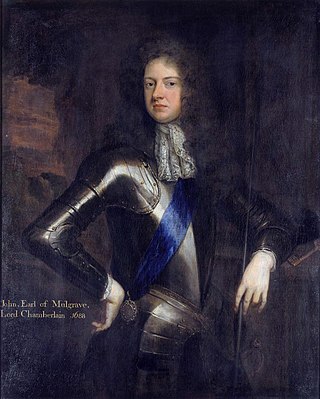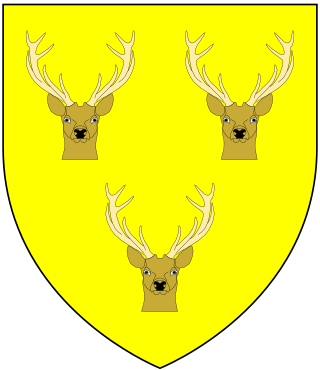
Duke of Buckingham and Normanby is a title in the Peerage of England. The full title was Duke of the County of Buckingham and of Normanby but in practice only Duke of Buckingham and Normanby was used. The dukedom was created in 1703 for John Sheffield, 1st Marquess of Normanby KG, a notable Tory politician of the late Stuart period, who served under Queen Anne as Lord Privy Seal and Lord President of the Council. He had succeeded his father as 3rd Earl of Mulgrave in 1658 and been made Marquess of Normanby in 1694.

Marquess of Waterford is a title in the Peerage of Ireland and the premier marquessate in that peerage. It was created in 1789 for the Anglo-Irish politician George Beresford, 2nd Earl of Tyrone. The title is presently held by Henry Beresford, 9th Marquess of Waterford.

Earl of Galloway is a title in the Peerage of Scotland. It was created in 1623 for Alexander Stewart, 1st Lord Garlies, with remainder to his heirs male bearing the name and arms of Stewart. He had already been created Lord Garlies in the Peerage of Scotland in 1607, with remainder to the heirs male of his body succeeding to the estates of Garlies. This branch of the Stewart family were distant relatives of the Stewart Kings of Scotland.

The title Earl of Newburgh was created in the Peerage of Scotland in 1660 for James Livingston, 1st Viscount of Newburgh, along with the subsidiary titles Viscount of Kynnaird and Lord Levingston.

Earl of Radnor, in the County of Wiltshire, is a title which has been created twice. It was first created in the Peerage of England in 1679 for John Robartes, 2nd Baron Robartes, a notable political figure of the reign of Charles II. The earldom was created for a second time in the Peerage of Great Britain in 1765 when William Bouverie, 2nd Viscount Folkestone, was made Earl of Radnor.

Earl of Romney is a title that has been created twice.
Earl of Bradford is a title that has been created twice, once in the Peerage of England and once in the Peerage of the United Kingdom. It was first created in 1694 for Francis Newport, 2nd Baron Newport. However, all the Newport titles became extinct on the death of the fourth Earl in 1762. The earldom was revived in 1815 for Orlando Bridgeman, 2nd Baron Bradford. The Bridgeman family had previously succeeded to the Newport estates. The title of the peerage refers to the ancient hundred of Bradford in Shropshire, and not, as might be assumed, to the city of Bradford, Yorkshire, or the town of Bradford-on-Avon in Wiltshire.

Viscount Gage, of Castle Island in the County of Kerry of the Kingdom of Ireland, is a title in the Peerage of Ireland. It was created in 1720 for Thomas Gage, along with the subsidiary title of Baron Gage, of Castlebar in the County of Mayo, also in the Peerage of Ireland. In 1744 he also succeeded his cousin as eighth Baronet, of Firle Place. The titles remain united. The Gage family descends from John Gage, who was created a baronet, of Firle Place in the County of Sussex, in the Baronetage of England on 26 March 1622. His great-grandson, the seventh Baronet, represented Seaford in Parliament. He was succeeded by his first cousin, Thomas Gage, 1st Viscount Gage, the eighth Baronet. He sat as a Member of Parliament for Minehead and Tewkesbury and also served as Governor of Barbados. In 1720, 24 years before succeeding in the baronetcy, he was raised to the Peerage of Ireland as Baron Gage and Viscount Gage. His second son was the military commander the Hon. Thomas Gage.

The title of Earl of Kenmare was created in the Peerage of Ireland in 1801. It became extinct upon the death of the 7th Earl in 1952.

There have been three baronetcies created for persons with the surname Booth, one in the Baronetage of England and two in the Baronetage of the United Kingdom. The 1916 creation remains extant, the 1835 creation became extinct in 1896 and the 1611 baronetcy has been dormant since 1797. The senior line of the first creation was elevated to the peerage as Baron Delamer and Earl of Warrington.
Vitus is a Latin given name meaning lively and may refer to:
There have been three baronetcies created for persons with the surname O'Neill, two in the Baronetage of Ireland and one in the Baronetage of the United Kingdom.
There have been six baronetcies created for persons with the surname Thomas, three in the Baronetage of England, one in the Baronetage of Great Britain and two in the Baronetage of the United Kingdom. Two of the creations are extant as of 2016.
Darell is a given name derived from an English surname, which was derived from Norman-French d'Airelle, originally denoting one who came from Airelle in France. There are no longer any towns in France called Airelle, but airelle is the French word for huckleberry. Notable people with the name include:

The Myddelton Baronetcy, of Chirke in the County of Denbigh, was a title in the Baronetage of England. It was created on 4 July 1660 for Thomas Myddelton, Member of Parliament for Flint, Montgomery and Denbighshire. He was the son of the politician and Parliamentary general Sir Thomas Myddelton and the grandson of Sir Thomas Myddelton, Lord Mayor of London in 1613. The second and third Baronets represented Denbighshire in the House of Commons. The title became extinct on the death of the fourth Baronet in 1718.

The Fanshawe Baronetcy, of Donamore in Ireland, was a title in the Baronetage of Ireland. It was created on 2 September 1650 for the diplomat, translator and poet Richard Fanshawe. He was the son of Sir Henry Fanshawe, the grandson of Thomas Fanshawe, the brother of Thomas Fanshawe, 1st Viscount Fanshawe and the nephew of Sir Thomas Fanshawe and William Fanshawe. The title became extinct on the early death of the second Baronet in 1694.
Ignatius White was an Irish advisor of Limerick origins to James II of England, who sent him to The Hague in 1687 as an envoy extraordinary. His father, Dominick White, was Mayor of Limerick in 1636. Both the father and son were granted the titles Marquess of Albyville and Count of Alby, as well as greatly augmented arms and other privileges, in 1679 by Leopold I, Holy Roman Emperor.
There have been two baronetcies created for persons with the surname Broke, one in the Baronetage of England and one in the Baronetage of the United Kingdom. Both creations are extinct.

There have been two baronetcies created for members of the Pryse family, one in the Baronetage of England and one in the Baronetage of the United Kingdom. Both creations are extinct.

Sir Peter Colleton, 2nd Baronet, FRS was an English baronet of the Colleton Baronets and an MP.








